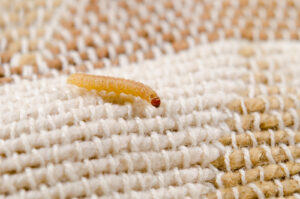What are Moths and How Do I Prevent an Infestation?
Your Moth Questions Answered.
Moths are nocturnal insects that belong to the order Lepidoptera. They are typically less colorful than butterflies. Most importantly, moths are considered pests when they get into your space. A moth infestation can damage or destroy food, upholstery and fabric products and create health hazards.
Like any other pest, the best way to combat moths in your home or business is to learn about their habits and how to prevent them. We’re here to help you defend your property against these pests by providing information on all-things moths.
What Do Moths Look Like?
There are two common categories of moths: pantry moths and fabric moths. The most common pantry moth is the Indian meal moth.
Indian Meal Moths average, 1/2 inch long with a wingspan of about 3/4 inches. Their wings are multi-colored in shades of rust, bronze, and copper. They have gray or silver markings close to their heads and brown or gray-brown thoraxes and abdomens. They are often found in pantries and dry food storage areas where they feast on grains and cereals.

The two most common fabric moths are the webbing moth and the casemaking clothes moth.
The Webbing Clothes Moth has a body that measures around 1/4 of an inch with a 1/2 inch wingspan. It’s lighter in color; typically golden, yellow, or tan with reddish-gold accents. It has split “sets” of wings. The lower set is lighter in shade than the upper set.

The Casemaking Clothes Moth is similar in size to the Webbing Clothes Moth with an average 1/4 inch body and 1/2 inch wingspan. It is also golden or yellowish-tan in coloring. Casemaking Clothes Moths have darker wings than Webbing Clothes Moths with small, black spots all over them.

What Do Moths Eat?
Moths consume most of their nutrition in their larval (caterpillar) stage. If adult moths do consume anything, it’s usually liquids from small plants, leaves, fruits, and flowers. Moth larvae, on the other hand, eat natural fibers. These fibers can be found in clothing, carpet, drapes, upholster, and more. If moths eventually run out of natural fibers, they may even snack on pet fur!
In the wild, moths and larvae eat fruits, seeds, grains, flowers, animal waste and natural fibers like cotton or silk.

What Fabrics Do Moths Eat?
Moths are attracted to naturally occurring fabrics such as silk, wool and cotton. They will also eat animal-based textiles like fur, feathers and leather. All of these materials contain keratin, a protein that moth larvae need for development. To flag a moth problem, learn how to identify moth holes in clothes. Look for small, uneven holes, especially along edges. In carpet and textiles, look for thin patches.
How Do Moths Eat?
Caterpillars have strong mandibles–or lower jaws– instead of teeth. Like scissors, these jaws are capable of grinding through various fabrics and textiles as well as leaves and plants.
Adult moths don’t have a mouth in the traditional sense but they do have a straw-like appendage that some species use for drinking nectar. It is physically impossible for a moth to bite you.
What Attracts Moths?
Webbing and casemaking clothes moths are attracted to fabric. You can find them in your closets and dressers. Commercial properties they’re most likely to bother include manufacturers and retail properties where they’re likely to infest places like dark storage rooms. Clothes moths leave plenty of signs of an infestation. Look for small bite holes, torn fabric, larvae or eggs on clothing, and tracks in dust on flat surfaces.
The Indian meal moth operates a little differently than the clothes moths. They are attracted to pantries, cupboards and food service businesses where they can find dry foods like grains, seeds, cereals, dried fruit and even pet food. Like clothes moths, the Indian meal moth lays eggs where they eat. Adult moths don’t eat, so if you find moth damage it’s because moth larvae were born nearby.
Why Do I Have So Many Moths Outside My House?
It’s probably outdoor lighting. Why are moths are attracted to light? Scientists believe that this is because they normally navigate by the moon’s light but become confused by outdoor lighting and other artificial light sources.
Once near or inside your home, they might seek food sources to lay eggs in. If they find what they are looking for, you may find yourself in the midst of an infestation.
What Do Moths Do During the Winter?
Unless they find warm lodging like your home or business, moths will die out when temperatures drop. Before they die, females will leave eggs in a state of diapause that is similar to hibernation. In the spring, the eggs will hatch as temperatures rise and the larvae will start the life cycle over.
How Long Do Moths Live?
Many species of adult moth only live a few days to a few weeks. In general, moths live anywhere from 1-6 moths. Lifespans vary widely depending on the type of moth and living conditions.

How Can I Prevent Moths?
Where do moths come from? They are probably entering through cracks around your home or holes in window screens. Make sure you periodically check and seal your home or building against moths and other pests.
- To prevent Indian Meal Moths, keep kitchens and food prep areas clean. Take away their food source by transferring your dry goods into hard plastic containers.
- To prevent clothes moths, make sure the humidity levels in your property aren’t too high. If you’re storing clothing long term, place it in plastic containers.
- To prevent both types of moth, stay on top of cleaning. Insects hate tidy, dust-free, food-free environments.
How Do I Get Rid of Moths?
When it comes to moth removal, your best bet is to contact a local commercial pest control company. The experts at Assured Environments can identify where moths get in and keep moths out of your property—contact Assured today!
